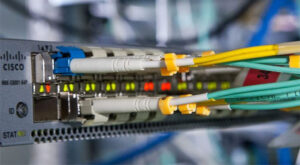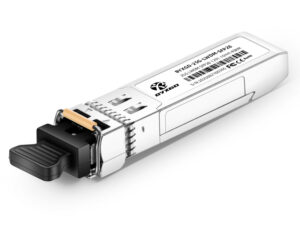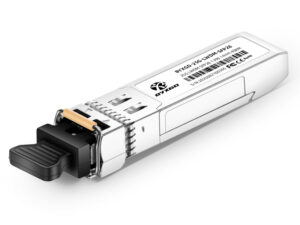Have you ever struggled with selecting optical modules that deliver the right balance of cost, performance, and scalability for your enterprise network? The right 25G LWDM SFP28 module will revolutionize your network as it increases speed and provides reliable long-distance dissemination of data. When you learn the benefits and technical fine points of differentiating a 25G LWDM SFP28 module, you can feel secure in optimizing your infrastructure for high capacity and future-proofing.

25G LWDM SFP28 Modules: Why They Are Ideal for Long-Haul and Enterprise Interconnects
25G LWDM SFP28 modules fit in between CWDM (Coarse Wavelength Division Multiplexing) and DWDM (Dense Wavelength Division Multiplexing), providing a great technology that combines some of the best characteristics of the two systems. Imagine CWDM like a broad highway with fewer lanes. Easy–but leaves a great deal of room for improvement–DWDM reflects a very busy expressway packed with tight lanes. The SFP28 module combines the ease of a straight expressway that offers higher capacity and longer distances than CWDM but is not as complex as full DWDM systems.
Moreover, 25G LWDM SFP28 modules can support more simultaneous channels, providing data transmission beyond typical distances without the costs of cooling and expensive hardware. It is a perfect solution for enterprise situations requiring reliable long-distance connectivity at a reasonable cost. While DWDM provides even more channels of transmission, the costs can be higher with a complicated set-up.
The SFP28 module combines more channels over longer distances by simplifying deployment with channels that are spaced wider together while using existing equipment, reducing complexity and cost.
The “25G + LWDM” advantages will translate to higher speeds of data transmission with maximum use of fiber. Long wavelength technology increases the usable spectrum with existing fibers, maximizing the number of channels and distance, while also using less power and enabling easy maintenance.
To sum it up, 25G LWDM SFP28 modules provide the scalability and reach of DWDM with an affordable solution that is simpler to handle, closer to the CWDM type of equipment. If you are in business and need reliability and scalability over immediate distances spanning campuses, metro areas, or regional areas, this type of technology is a perfect fit.
Key Benefits in Brief
- Allows for longer transmission distances beyond what CWDM can be used reliably
- Can double or triple channel capacity compared to CWDM, which means more bandwidth without replacing fiber
- Lower costs to deploy and maintain compared to DWDM operational costs of wavelength management and control
- Less power is used, reducing cooling and operational equipment costs
- Usable with almost any 25G capable switch and LWDM multiplexers
25G LWDM SFP28 modules offer technology combining speed, distance, and costs to help keep networks working in the middle without being overpriced or underutilized.
25G LWDM SFP28 Technical Deep Dive and Selection Framework
The key technology in 25G LWDM SFP28 modules involves the management of wavelengths at which they transmit light. These modules transmit light in a very specific band, approximately covering the area from 1571 nm to 1600 nm. Within this limited space, multiple channels exist with only 1.6 to 2 nm spacing between each channel. This means that data streams can densely populate a fiber link without any cross-talk.
The figure below shows an example of the typical spacing of LWDM channels, showing how each channel occupies a unique position on the wavelength.
When thinking about which 25G LWDM SFP28 module works for your application, three main factors can direct your choice:
- Transmission Distance: Are you trying to connect two buildings on a campus, citywide, or regionally? Long transmission distances require modules that have enough optical budgets, especially if they also use multiplexers/demultiplexers.
- Channel Density: How many data streams need to travel on the fiber at the same time? More channels will increase each unit’s complexity, so while more channels are helpful for capacity, they also increase the complexity and price.
- Budget: You will want to keep in mind your budget for modules and maintenance over the life of the module to achieve desired performance and scalability.
This should simplify your selection process:
- If your link is greater than 10 km, LWDM modules provide better reach than CWDM.
- If your application has more than a handful of channels, LWDM provides better density than CWDM without committing to DWDM.
- If you are budget-driven and have clear performance objectives, the value proposition of LWDM modules is a good balance.
Compatibility with your existing infrastructure is essential. 25G LWDM SFP28 modules must work with existing LWDM MUX/DEMUX equipment combinations to separate wavelengths on the fibers. Modules are also compatible across vendors, including industry-leading brands such as Cisco, Juniper, and Huawei, which helps mitigate deployment risks in mixed vendor environments.
Selection Criteria Overview
| Selection Criterion | Description | Why It Matters | 25G LWDM SFP28 Advantage |
| Transmission Distance | Signal reach capability | Longer distances require better optics | Typically supports 40-80 km, outpacing CWDM |
| Channel Density | Number of simultaneous signals | Determines network capacity and complexity | 8-12 channels, nearly doubling CWDM capacity |
| Budget | Capital and operational costs | Influences scope of deployment | Balanced cost vs. DWDM, affordable scalability |
| Compatibility | Operation with multi-vendor gear | Simplifies mixed network environments | Compatible with major vendors’ equipment |
| Energy Efficiency | Power usage and heat management | Reduces running costs and environmental impact | Lower than DWDM, leading to easier maintenance |
To start, when determining distance and bandwidth requirements, the optimal module accomplishes the goal of maximizing spectral efficiency while balancing cost and installation issues.
25G LWDM SFP28 Modules Product Lineup

BYXGD-25G-LWDM-SFP28-1286.66nm-40KM: The SFP28 module operating at 25G LWDM has a data rate of 25 Gbps and operates over single-mode fiber (SMF), which is capable of distances of up to 40 km. The module operates at a wavelength of 1286.66 nm and has an EML LWDM (extreme high-speed light wavelength division multiplexing) transmitter and APD receiver along with a duplex LC connector, TX power of -2 to 6 dBm, and RX sensitivity of below -19 dBm. Power consumption is 1.5 W with a 4 dB extinction ratio. This module will provide a reliable, long-distance, efficient connectivity solution for enterprise networking and will work well with Cisco, NVIDIA/Mellanox, Arista, and other manufacturers providing 25G LWDM solutions.

BYXGD-25G-LWDM-SFP28-1291.10nm-40KM: This 25G LWDM SFP28 module operates at a wavelength of 1291.10 nm and supports a data rate of 25 Gbps on single-mode fiber with a reach of 40 km. The SFP28 module features an EML LWDM transmitter and APD receiver with a TX power of -2 to 6 dBm and sensitivity of less than -19 dBm. It is equipped with a duplex LC connector for integration simplicity. The module consumes 1.5 watts of power and has an extinction ratio of 4 dB. This 25G LWDM SFP28 module is compatible with major manufacturers such as Juniper, Brocade, and Huawei and is designed for scalable, long-distance networking.

BYXGD-25G-LWDM-SFP28-1295.56nm-40KM: This module operates on a wavelength of 1295.56 nm at 25 Gbps over single-mode fiber with a reach of 40 km. It includes an EML LWDM transmitter, an APD receiver, and a duplex LC connector. TX power is -2 to 6 dBm and sensitivity is -19 dBm or better. It operates at low power (1.5 W) with an extinction ratio of 4 dB. Compatible with leading brands such as Cisco and Arista, the module is perfect for cost-effective scalable optical networks.

BYXGD-25G-LWDM-SFP28-1300.05nm-40KM: This 25G LWDM SFP28 module is designed for a wavelength of 1300.05 nm, delivering a 25 Gbps data rate over a distance of 40 km of single-mode fiber optics. The module provides an EML LWDM transmitter, an APD receiver, and a duplex LC connector. The TX power ranges from -2 to 6 dBm and the receiver sensitivity is less than -19 dBm. Power consumption is rated at 1.5 W with an extinction ratio of 4 dB. Compatible with Broadcom, Juniper, and more, the 25G LWDM SFP28 is ideal for enterprise-grade, long-reach connectivity.

BYXGD-25G-LWDM-SFP28-1304.58nm-40KM: This 25G Long Wavelength Division Multiplexing (LWDM) Small Form-Factor Pluggable (SFP28) transceiver operates at 1304.58 nm to provide 25 Gbps over single-mode fiber for an optical reach up to 40 kilometers. The transceiver utilizes an EML LWDM transmitter and an APD receiver with the following performance specifications: Tx Power: -2 to +6 dBm; Sensitivity: < -19 dBm; Duplex LC; Operating Power: 1.5 W; Extinction Ratio: 4 dB. These specifications contribute to the module’s broad compatibility with optical equipment from Cisco, Brocade, Huawei, and other manufacturers. The module is highly applicable for enterprise networks and metropolitan area networks.

BYXGD-25G-LWDM-SFP28-1309.14nm-40KM: The 25G LWDM SFP28 module operates at a wavelength of 1309.14 nm to transmit data rates of 25 Gbps over single-mode fiber to a distance of 40 km or less. This module uses an EML LWDM transmitter, an APD photodiode receiver, a duplex LC connector, has a TX power of -2 to 6 dBm, receiver sensitivity of -19 dBm, 1.5 W power consumption, and an extinction ratio of 4 dB. This module is compatible with equipment from many manufacturers, including Cisco, NVIDIA/Mellanox, and Juniper. This is a strong option for network applications requiring scalable networks.
Use Case and Future Trends in 25G LWDM SFP28
A global manufacturer experienced slow data speeds between their plants and headquarters. The legacy network could not manage real-time monitoring and control capabilities, leading to a crucial need for affordable upgrades to an outdated infrastructure that required a complete overhaul.
The manufacturer installed 25G LWDM SFP28 modules into their current fiber network and multiplexers and increased channel capacity and reach up to 50 km. The modules were easily integrated into the existing switches and equipment and increased data transfer speed while maintaining continuous connectivity to sites.
The manufacturer’s outputs increased throughput by 40%, allowing for quicker decisions and gathering useful information while improving overall efficiency. The ROI on the upgrade was recovered within several months by decreasing downtimes and increasing throughput.
In the future, as 100G+ technologies evolve, the role of LWDM will change. As enterprises continue to increase bandwidth, the need to move to 25G LWDM and higher-speed optics will evolve. 25G LWDM will afford the enterprise flexible, low-cost options to grow their bandwidth needs. LWDM’s ease of deployment will allow enterprises to add reliable reach without overhauling an existing fiber plant.
In the future, hybrid network architectures are likely, using LWDM modules to achieve various speeds; the potential utility of these modules will capture the benefits of both technologies. This new architecture will assist with gradual upgrades to an infrastructure while preserving initial capital—balancing current speeds with future needs will use various types of technology.
In conclusion, 25G LWDM SFP28 modules provide an efficient solution today while allowing for scalable and flexible networks for the future.
FAQs
Tuning is not typical. Unlike other optical modules, the 25G LWDM SFP28 modules utilize fixed wavelengths that use standard multiplexers, enabling simple and efficient setup.
Yes. Since the wavelengths are carefully managed, traffic is delivered with coexistence equipment to avoid channel interference.
The optical budget can be calculated by subtracting the receiver sensitivity and fiber/connector losses from the transmitter output power. These calculations will show that you have the margin required to support the distance and losses of your network.
Compatibility will vary based on the router or switch hardware that your network supports. Third-party modules should be checked for compatibility before considering your purchase.
The distance is typically between 40 km and 80 km and is usually suited for connections in metropolitan and regional networks.
Contact Us For The Best Solution
25G LWDM SFP28 modules, with their long-distance reach, high channel capacity, and low cost, make them a must-have for a scalable and reliable EI and IT enterprise network. Consider the needs of your network, and don’t forget to speak to an expert about the modules in terms of your specific infrastructure requirements.
